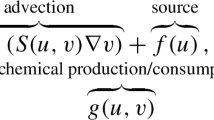Summary
The dynamical behavior of a class of biochemical control circuits that regulate enzyme or protein synthesis by end-product feedback is analyzed. Both inducible and repressible systems are studied and it is proven that in the former unique steady states are globally asymptotically stable. This precludes periodic solutions in these systems. A similar result holds for repressible systems under certain constraints on kinetic parameters and binding contants. However, when the reaction sequence is sufficiently long, or when a large enough number of effector molecules bind to each represser molecule, repressible systems can show zero-amplitude (“soft”) bifurcations: these are predicted by Hopf's bifurcation theorem.
Similar content being viewed by others
References
Aizerman, M. A., Gantmacher, F. R.: Absolute Stability of Regulator Systems. San Francisco: Holden-Day 1964.
Aronson, D. G.: A comparison method for stability analysis of nonlinear parabolic problems. Preprint (1975).
Atkinson, D. E.: Biological feedback control at the molecular level. Science 150, 851–875 (1965).
Bourgeois, S., Monod, J.: Lac regulatory system, in: Control Processes in Multicellular Organisms (Wolstenholme, G., Knight, J., ed.) London: Churchill 1970.
Brauer, F., Nohel, J.: The Qualitative Theory of Ordinary Differential Equations. New York: Benjamin 1969.
Caplan, S. R., Naparstek, A., Zabusky, N. J.: Chemical oscillations in a membrane. Nature 245, 364–366 (1973).
Glass, L., Kauffman, S. A.: Co-operative components, spatial localization and oscillatory cellular dynamics. J. Theor. Biol. 34, 219–237 (1972).
Goodwin, B. C.: Oscillatory behavior in enzymatic control processes, in: Adv. in Enzyme Regulation, 3 (Weber, G., ed.). Oxford: Pergamon 1965.
Goodwin, B. C.: Biological control processes and time. Ann. N. Y. Acad. Sci. 31, 748–758 (1969).
Griffith, J. S.: Mathematics of cellular control processes. J. Theor. Biol. 20, 202–216 (1968).
Hastings, S., Tyson, J., Webster, D.: Existence of periodic solutions for negative feedback control systems. Preprint (1975).
Hsü, I., Kazarinoff, N. D.: An applicable Hopf bifurcation formula and instability of small periodic solutions of the Field-Noyes model. J. Math. Anal. and Applic. (to appear, 1976).
Hunding, A.: Limit cycles in enzyme systems with nonlinear negative feedback. Biophys. Struct. Mech. 1, 47–54 (1974).
Kato, T.: Perturbation Theory for Linear Operators. New York: Springer 1966.
Lee, E. B., Markus, L.: Foundations of Optimal Control Theory. New York: J. Wiley 1967.
Mitchison, J. M.: The Biology of the Cell Cycle. Cambridge: Cambridge Univ. Press 1971.
Morales, M., McKay, D.: Biochemical oscillations in “controlled” systems. Biophys. Jour. 7, 621–625 (1967).
Minc, H., Marcus, M.: A Survey of Matrix Theory and Matrix Inequalities. Boston: Prindle, Weber and Schmidt 1964.
Ruelle, D., Takens, F.: On the nature of turbulence. Comm. Math. Phys. 20, 167–192 (1971).
Tomkins, G. M., Gelehrter, T. D., Granner, D., Martin, D., Samuels, H. H., Thompson, E. B.: Control of Specific Gene Expression in Higher Organisms. Science 166, 1474–1480 (1969).
Tyson, J. J.: On the existence of oscillatory solutions in negative feedback cellular control processes. J. Math. Biol. 1, 311–315 (1975).
Walter, C.: Stability of controlled biological systems. J. Theor. Biol. 23, 23–38 (1969).
Walter, C.: The absolute stability of certain types of controlled biological systems. J. Theor. Biol. 23, 39–52 (1969).
Walter, C.: Oscillations in controlled biochemical systems. Biophys. Jour. 9, 863–872 (1971).
Yagil, G., Yagil, E.: On the relation between effector concentration and the rate of induced enzyme synthesis. Biophys. Jour. 11, 11–27 (1971).
Yagil, G.: Quantitative aspects of protein induction, in: Curr. Top. Cell. Reg. 9 (Horecker, B. L., Stadtman, E. R., eds.). New York: Academic Press 1975.
Yates, R. A., Pardee, A.: Control of pyramidine biosynthesis in E. coli by a feedback mechanism. J. Biol. Chem. 221, 757–765 (1956).
Author information
Authors and Affiliations
Rights and permissions
About this article
Cite this article
Othmer, H.G. The qualitative dynamics of a class of biochemical control circuits. J. Math. Biology 3, 53–78 (1976). https://doi.org/10.1007/BF00307858
Received:
Issue Date:
DOI: https://doi.org/10.1007/BF00307858




